
The Rob Palmer Blue Holes Foundation
Introduction to Cave Environment
Mother Earth provides us a number of interesting and exciting places to dive but few surpass the amazing splendor of many underwater caverns and caves.
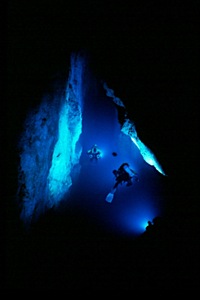
Photo Bill Stone
Many caves, depending on their location and the nature of the water that flows through them (i.e. fresh vs. salt), do not harbour the variety and abundance of plant and animal life found on coral reefs and the open sea, so we thought. Now, based on passed and ongoing exploration and research, we now know that we have the abundance and variety of life in these caves, its just different and not so obvious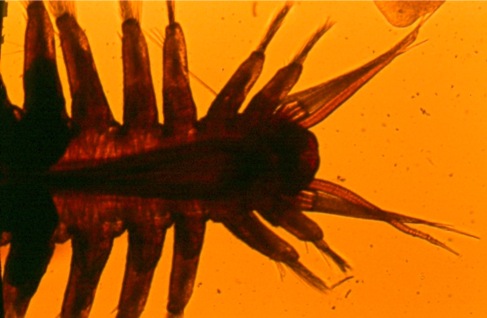

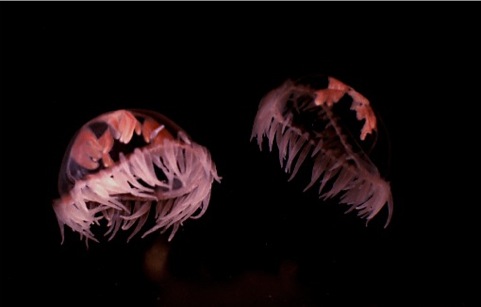
Polychaete Worm from Lucayan Caverns, Grand Bahama
Medusa (Jelly fish) from a fracture cave on South Andros
Photo Chris Howes
The difference between a cavern and a cave is that a cavern always has natural light flooding into the passage space whereas a cave has no natural light that can be seen. This would mean that if an opening to a cavern is relatively small, night diving would change the rules and make the cavern a cave setting.
So the rule of thumb is:
* If you don't see natural light, your in a cave
* If you see natural light, your in a cavern
This is extremely important when it comes to training and the type of gear that you are using.
What are Blue Holes and Black Holes?
In holiday language, these are entrances into some of the world’s most spectacular underwater cave systems (3) (4) In the scientific world, we don’t call them by the colour of their watery entrances, which by the way, when sea level drops, are no longer blue, but their still caves. On the colour front, the one exception is the Black Holes. If sea level were to drop, the bowl shaped entrance would be still black and very stinky. Now we name them by the way they formed. We call them either horizontal caves, vertical caves or fracture caves. So, if a person asks, ‘what are those openings?’ the answer, ‘blue holes,’ tells you nothing about the cave except the colour of the entrance, however the better answer of any of the afore mentioned names already tells you how the cave has formed and what to expect geologically if you were to dive one of these systems.
Their openings can be found among the shallow creeks, inland lakes, and the shallow banks of the Bahamas. The caves, which have developed within the Bahamian carbonate platforms, can be laterally and vertically very extensive. Lateral cave passages can extend to several kilometres and vertically may range in depth from ten to several hundred metres. Black holes fall into the vertical category. These caves form as a result of very strong microbial influence (5). These caves thus far have only been found to form in the tidal flats on the west side of Andros and a few have been found on the north shore on Grand Bahama.
For many years, ideas about the origin of these caves has been mixed with local superstition and myth. The caves found in the marine setting are sometimes referred to by native Bahamians as "blowing" or "boiling" holes, a phenomenon supposedly created by a mythical creature called the "Lusca" a beast that is half squid and half shark; a belief still shared by many Bahamians today.
The "blowing" and "sucking" phenomena are largely caused by differences in water surface elevation across the Bahamian platform generated by tides, local wave action, and ocean currents, the latter explanation not being so romantic.
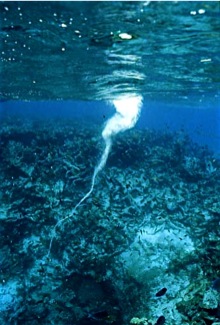
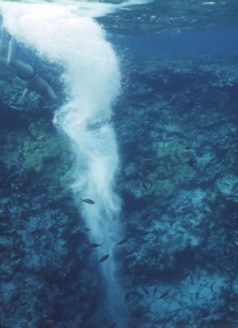
A short time after high tide, the hydraulic head is higher on the platform then in the island creating a vortex or sucking phenomena. The picture on the left is showing the vortex forming and the picture on the right is when it is in full sucking mode. These currents are strong enough to keep a diver from escaping a cave and strong enough to draw down a slightly submerged boat and anyone swimming close by.
Biogenic Hypothesis for the formation of caves in The Bahamas: An old idea?
In 1904, scientific papers were being published suggesting that bacteria were generating different acids that could be involved in the alteration and subsequent dissolution of rocks. A definitive paper was published in 1910 that demonstrated that bacteria indeed were involved in rock decay. In 1933, an additional paper was published that confirmed earlier work in this area. There results attested to the fact that of the 58 strains of isolated, viable bacteria, all fell into a category either of fermenting, sulphate reducing, and nitrifying bacteria. Many of the strains of bacteria were found to produced CO2 whereas others produced sulphuric, and nitric acid. These microbes were found not only living on the surface of the host rock but two feet deep into the stone.
Research into cave formation in modern-day carbonate platforms has generated virtually parallel results from the 1933 work done mostly in Europe. As in the 1933 research, we have identified viable bacterial populations not only in the rocks in caves currently above sea level but also in the rock of the caves currently in the phreatic zone. As in earlier work, we have shown that the bacterial population that lives in the dry cave rock is different from those that are found in the drip water. We were able to isolate 12 different species of bacteria in the dry wall rock of which two species, which, were isolated in the stones, were the same found in rainwater. CO2 measurements made in Altar Cave revealed a CO2 production rate for that time of collection of 2.2 g CO2/kg/day, (R=0.7) compared to 0.13g CO2/kg/day from stone.
The currently accepted hypothesis for the development of secondary porosity (caves) in carbonate island settings suggests that mixing of CaCO3 supersaturated seawater with CaCO3 saturated groundwater creates undersaturated mixed water that is thought to be responsible for large-scale carbonate dissolution although it is known that soon after rainwater has moved through the soil and makes contact with the underlying limestone it becomes buffered by dissolution of CaCO3. In the biogenic hypothesis, we state that the dissolutional capacity of the vadose water is primarily controlled by the assimilation of CO2 and other acids produced by bacteria living in the pores and fractures of the host rock. It is interesting that this research did not reach the karst community, and that if it had, the prevailing physico-chemical models used by karst researcher might never have been developed, and our “new” ideas would instead be old hat. (2)
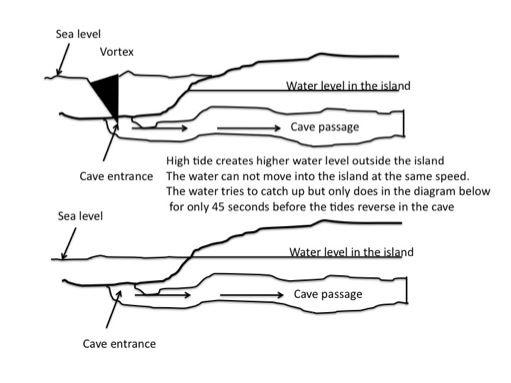
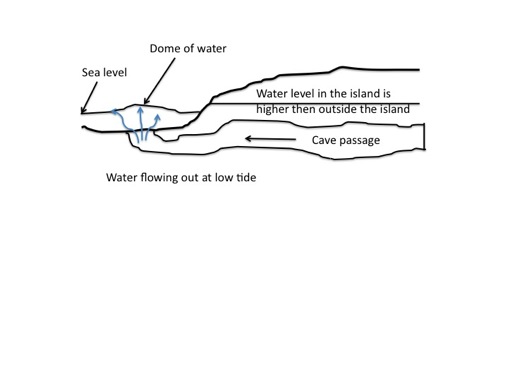
The hydraulic head is the water level above another and the weight or pressure of that volume of water. When they are equal there is no movement up or down. On the islands, this neutral time has been measured to be 45 seconds unless there is a storm.